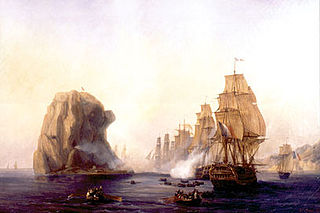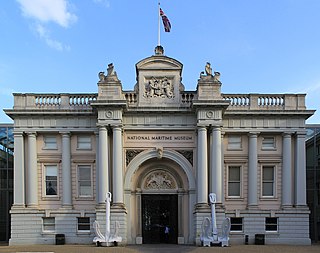Ship commissioning is the act or ceremony of placing a ship in active service, and may be regarded as a particular application of the general concepts and practices of project commissioning. The term is most commonly applied to the placing of a warship in active duty with its country's military forces. The ceremonies involved are often rooted in centuries old naval tradition.

A warship or combatant ship is a naval ship that is built and primarily intended for naval warfare. Usually they belong to the armed forces of a state. As well as being armed, warships are designed to withstand damage and are usually faster and more manoeuvrable than merchant ships. Unlike a merchant ship, which carries cargo, a warship typically carries only weapons, ammunition and supplies for its crew. Warships usually belong to a navy, though they have also been operated by individuals, cooperatives and corporations.

USS Mitscher (DDG-57) became the second United States Navy warship named to honor Admiral Marc A. Mitscher (1887–1947), famed naval aviator and World War II aircraft carrier task force commander. In 1988 the U.S. Navy contracted with Ingalls Shipbuilding, in Pascagoula, Mississippi to build the seventh ship of the Arleigh Burke class.

The Blockade of Africa began in 1808 after the United Kingdom outlawed the Atlantic slave trade, making it illegal for British ships to transport slaves. The Royal Navy immediately established a presence off Africa to enforce the ban, called the West Africa Squadron. Although the ban initially applied only to British ships, the UK negotiated treaties with other countries to give the Royal Navy the right to intercept and search their ships for slaves. A notable exception was the United States, which refused such permission. The 1807 Act Prohibiting Importation of Slaves technically abolished the intercontinental slave trade in the United States but the ban was not widely enforced and many of the slave ships which escaped the blockade were destined for the southern United States.

Informally, a stone frigate is a naval establishment on land. The term has its origin in Britain's Royal Navy after its use of Diamond Rock, off Martinique, as a 'sloop of war' to harass the French. The command of this first stone frigate was given to Commodore Hood's first lieutenant, James Wilkes Maurice, who, with cannon taken off the Commodore's ship, manned it with a crew of 120 until its capture by the French in the Battle of Diamond Rock in 1805.

Royal Navy Dockyards were harbour facilities where commissioned ships were either built or based, or where ships were overhauled and refitted. Historically, the Royal Navy maintained a string of dockyards around the world; these publicly owned establishments were officially designated Royal Dockyards or HM Dockyards until the late 1960s. Today, the few shipbuilding/maintenance yards that remain operational have been privatized ; and Babcock International, which in 2011 acquired freehold ownership of the working North Yard at Devonport from the British Ministry of Defence, has reverted to calling it Devonport Royal Dockyard.
A flag officer is a commissioned officer in a nation's armed forces senior enough to be entitled to fly a flag to mark the position from which the officer exercises command.

Her Majesty's Naval Base, Portsmouth is one of three operating bases in the United Kingdom for the Royal Navy. Portsmouth Naval Base is part of the city of Portsmouth; it is located on the eastern shore of Portsmouth Harbour, north of the Solent and the Isle of Wight. Until the early 1970s, it was officially known as Portsmouth Royal Dockyard ; thereafter the term 'Naval Base' gained currency, acknowledging a greater focus on personnel and support elements alongside the traditional emphasis on building, repairing and maintaining ships. In 1984 Portsmouth's Royal Dockyard function was downgraded and it was formally renamed the 'Fleet Maintenance and Repair Organisation' (FMRO). The FMRO was privatized in 1998. Around the year 2000, the designation HMS Nelson was extended to cover the entire base.

The Surface Fleet is one of the five fighting arms of the Royal Navy. It consists of the Surface combatants. The surface fleet is administered by Rear-Admiral Andrew Burns This appointment has an additional operational role as Commander United Kingdom Maritime Forces, a sea-going combatant command appointment.

HMS Spiteful was a Spiteful-class torpedo boat destroyer built at Jarrow, England, by Palmers Shipbuilding and Iron Company for the Royal Navy and launched in 1899. Specified to be able to steam at 30 knots, she spent her entire career serving in the seas around the British Isles.

A naval trawler is a vessel built along the lines of a fishing trawler but fitted out for naval purposes. Naval trawlers were widely used during the First and Second World Wars. Fishing trawlers were particularly suited for many naval requirements because they were robust boats designed to work heavy trawls in all types of weather and had large clear working decks. One could create a mine sweeper simply by replacing the trawl with a mine sweep. Adding depth charge racks on the deck, ASDIC below, and a 3-inch (76 mm) or 4-inch (102 mm) gun in the bow equipped the trawler for anti-submarine duties.

HMS Calliope was a Calypso-class corvette of the Royal Navy which served from 1887 until 1951. Exemplifying the transitional nature of the late Victorian navy, Calliope was a sailing corvette – last such ship built for the Royal Navy – but supplemented the full sail rig with a powerful engine. Steel was used for the hull, and like the earlier iron-hulled corvettes, Calliope was cased with timber and coppered below the waterline, in the same manner as wooden ships.

Pearl Harbor is a lagoon harbor on the island of Oahu, Hawaii, west of Honolulu. It has been long visited by the Naval fleet of the United States, before it was acquired from the Hawaiian Kingdom by the U.S. with the signing of the Reciprocity Treaty of 1875. Much of the harbor and surrounding lands is now a United States Navy deep-water naval base. It is also the headquarters of the United States Pacific Fleet. The U.S. government first obtained exclusive use of the inlet and the right to maintain a repair and coaling station for ships here in 1887. The attack on Pearl Harbor by the Empire of Japan on December 7, 1941, was the immediate cause of the United States' entry into World War II.
HMS Advice was a 10-gun cutter that the Royal Navy purchased in 1779. She was wrecked in 1793.

Navy Command is the current headquarters body of the British Royal Navy, and its major organisational grouping. It is a hybrid, neither a command, nor simply an installation. Royal Navy official writings describe Navy Command Headquarters both as a physical site, on Whale Island, a collective formed of the most senior RN officers, and as a budgetary grouping.
Lieutenant is a commissioned officer rank in many nations' navies. It is typically the most senior of junior officer ranks. The rank's insignia usually consists of two medium gold braid stripes and often the uppermost stripe features an executive curl.
HMS Gibraltar Prize, also known as HMS Gibraltar's Prize, was a sloop of the Royal Navy. She began life as the French privateer schooner Glaneur, but HMS Gibraltar captured her on 10 December 1756, or February or March 1757; prize money was paid on 3 January 1758. The Admiralty purchased her on 12 February 1757 for £795 9s and the Royal Navy took her into service under the name Gibraltar's Prize. The Admiralty sold her in 1761.
HMS Ostrich was a Fairfield three-funnel, 30-knot torpedo boat destroyer ordered by the Royal Navy under the 1898 – 1899 Naval Estimates. In 1913 she was grouped as a C-class destroyer. She was the first Royal Navy ship to carry this name. She spent most of her operational career in home waters, operating with the Channel Fleet as part of the Portsmouth Instructional Flotilla, and was sold for breaking in 1920.
HMS Childers was a Royal Navy 18-gun Cruizer-class brig-sloop, built by Nicholas Diddams at Portsmouth Dockyard and launched in 1812. She was broken up in 1822.


















